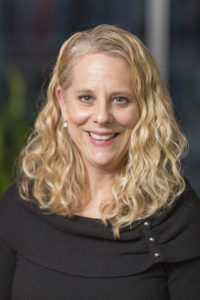SHSMD’s Latest Report Helps Marketers Navigate Rapidly Changing Health Care World
// By Lisa D. Ellis //

Holly Sullivan, director of strategic partnerships for Spectrum Health, and vice chair of SHSMD’s Bridging Worlds Committee
This is a pivotal time in health care as conditions continue to shift rapidly, posing new challenges for health care organizations, regardless of size, structure, or location. That’s why SHSMD’s latest publication offers a roadmap that can be tailored for any situation, to empower marketers and strategists to help their organizations—and their careers—thrive amid this dynamic landscape.
Universal Reach
At the annual meeting of the Society for Healthcare Strategy & Market Development (SHSMD) in September 2017, a group of health care strategists from the Middle East came all the way to Orlando, Florida to attend the presentations. When they introduced themselves to SHSMD representatives, they revealed that they had made the trip to attend the conference specifically because they saw SHSMD’s recently released report Bridging Worlds: The Future Role of the Healthcare Strategist Second Edition. They seemed excited by how well it applied to their circumstances, and were eager to take advantage of the wealth of knowledge SHSMD had to offer.
While most of the other conference attendees had not traveled such a distance, that the lessons provided in SHSMD’s latest interactive marketing guide have such global reach is not surprising—at least not to the experts who helped produce this comprehensive strategy piece and the interactive tools that go with it on SHSMD’s website. The goal of the report is to provide a framework that can apply to a variety of organizations, both in the United States and—as the Middle East contingent demonstrated—beyond.
Bridging Worlds
Bridging Worlds is an updated version of an earlier report that introduced emerging trends in health care. The new report builds on the original document by providing additional guidance for marketing folks and other strategy leaders to help them position themselves and their organizations to respond to new and growing pressures in the field.
The updated version builds on lessons learned in the original document and goes a step further by adding an interactive component that enables people to assess their current skills (and their teams’ skills), identify areas they need to develop, and establish a roadmap to help their organization respond to latest developments in the field.
“When we started the first version of Bridging Worlds, which was published in 2014, the important question we were trying to answer was what we, as strategists—including marketers, PR reps, communications staff, planners, and business development experts—need to know to lead our organizations in an environment where change is coming so fast,” explains Holly Sullivan, director of strategic partnerships for Spectrum Health in Michigan, who also serves as vice chair of SHSMD’s Bridging Worlds Committee. “In the first report, we identified the major trends that are happening in the industry and looked at how these will impact our jobs,” she says.
Now fast-forward three years. Sullivan says that changes in the field continue apace. To keep up, she says that organizations increasingly need to break down silos and find more effective ways to work toward common goals. This requires all participants to know exactly what they bring to the table and how their skills and knowledge can help their organizations.
Bridging Worlds 2nd Ed. offers five recommendations to guide health care strategists’ efforts. These include:
- Be Nimble to Exceed the Rate of Change
- Create Consumer Experiences, Tell Powerful Stories
- Integrate and Co-Create
- Erase Boundaries of Business
- Generate Data-Driven Insight
“That’s why in the updated report, we offer readers ways to assess their competencies and skills,” Sullivan says, pointing to an online tool that people can use through SHSMD’s website to determine how their experience best fits in with their vision for the future, and also to identify gaps in training and knowledge.
“Once you identify the gaps you want to address, you can then use SHSMD’s website to find experts or training resources to help you strengthen these areas,” she says.
Exploring Emerging Trends
One area of growing interest that marketers and others need to address is entrepreneurship, which refers to using predictive data and other analytical methods to understand the future health care needs of the population they serve. Another area that health care marketers need to consider is consumerism, which describes the trend toward patients taking a more active role in their own health care decisions. For marketing folks not well versed in these areas, it can be essential to build up their knowledge base so they can meet future challenges.
Sullivan says that by keeping these and other emerging trends in sight, marketers can help their organizations embrace them effectively. “A lot of us are aware of the trends, but we don’t know how they will affect our jobs in the future,” she says.
Incorporating Input from Consumers
At Spectrum, for instance, Sullivan admits that until recently she and her staff didn’t use consumers’ viewpoints to their full advantage.
“All too often, health care organizations make decisions without seeking input from the people they serve,” she says. Bridging Worlds helped her become more aware of the importance of mindfully incorporating the consumer perspective when developing a business plan for a new concept in primary care and wellness geared toward busy professionals.
“The report reminded us that we needed to look at employers in the community as partners who could help us better define the concept by telling us how to best serve them. Therefore, we went out and talked to a variety of businesses and interviewed them to ask for their input on what would be most valuable to them, and then we developed our whole plan around their feedback. This input enabled us to be sure we evolved the model to best meet consumer needs,” she adds.
Using Data to Tell Stories

Donna Teach, chief marketing and communication officer for Nationwide Children’s Hospital
Of course, Spectrum is just one of many organizations currently putting Bridging Worlds’ recommendations to work to further its impact. And in many cases, the impact is not limited to the target audience but can also have a profound effect on staff, according to Donna Teach, chief marketing and communication officer for Nationwide Children’s Hospital in Columbus, Ohio. Teach is also committee chair of SHSMD’s Bridging Worlds Committee.
“At Nationwide Children’s, we are in the process of introducing business intelligence tools, and we need to understand how to draw out the data to tell effective stories to drive meaningful change,” Teach says. Bridging Worlds’ lessons and interactive resources can help her staff determine how best to use what they have.
She says that her department will need new skills and behaviors as it transforms from a traditional marketing department to mar-tech, the new way of the health care world. She plans to use the SHSMD online assessment, a key part of a learning system called “SHSMD Advance,” to find out where her employees are already strong and where they should focus on building new skills that will be relevant in the next few years.
Advice for Others
For any marketing expert looking to lead his or her organization to meet current and future changes in health care, Teach says tools provided by Bridging Worlds and its online component “SHSMD Advance” can be critical.
She offers the following suggestions for strategists to put Bridging Worlds resources to work:
- As an individual, take the online “SHSMD Advance” assessment to understand your strengths and weaknesses relative to Bridging Worlds, and then have a critical conversation with your leader about your professional development and areas you would like to strengthen.
- As a team, take the online assessment and the results for your department, which can give you insight into where to look for outside resources to fill some of the gaps. This could mean hiring a consultant to work with your group or planning a staff development training, or both.
- Use design thinking and assessment information you glean from Bridging Worlds to develop job competencies and career ladders to write stronger job descriptions and define more strategic career paths within your organization.
- Share emerging trends and other key points with your senior leaders and board members to get everyone on the same page. If you don’t yet have a formal strategic plan, this can help you develop one addressing market conditions and forces acting on your organization.
- Keep in mind that how everyone uses Bridging Worlds and accompanying tools may be different. The information should be viewed not as a prescription for your organization, but rather as a lens to see which changes are most relevant and how you will address the implications.
Share Your Stories
Remember that one of the ways that tools like Bridging Worlds can help move the health care field forward is by providing a forum for organizations to share their strategies and lessons learned.
If you have a story to share how your organization uses Bridging Worlds or other timely tools to identify and respond to emerging trends, we want to know! Email details to editor@strategicHCmarketing.com for possible inclusion in a future story.
Lisa D. Ellis is editor of Strategic Health Care Marketing. She is a journalist and content development specialist who helps hospitals and other health care providers and organizations shape strategic messages and communicate them to their target audiences. You can reach her at editor@strategicHCmarketing.com.
